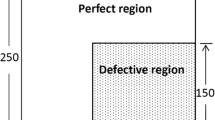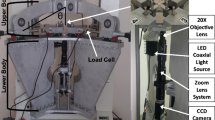Abstract
This work reports for the first time capacitance-based nondestructive evaluation (NDE) of a monolithic metal, namely steel. This means that the structural material is self-sensing, without the need for embedded or attached sensors. The capacitance (2 kHz) can be through-thickness (involving sandwiching electrodes) or in-plane (involving coplanar electrodes), with the latter being superior for NDE, partly due to the relative permittivity being higher in-plane (2 × 106) than through-thickness (28), and partly due to the more effective spreading of the in-plane electric field lines between the coplanar electrodes than the spreading of the through-thickness field lines between the sandwiching electrodes. The fringing field serves as the probe for the flaws at various distances from the electrodes, which are much smaller in area than the specimen. Due to the electrical conductivity of the specimen and the fact that an LCR meter is not designed for measuring the capacitance of a conductive material, each electrode is separated from the specimen by a dielectric film. The conductivity of the specimen accentuates the fringing field. The flaws cause the apparent capacitance to increase, due to the increase in the effective area reached by the fringing field. The capacitance increases monotonically with increasing damage, except that it decreases when the damage in the form of through holes is severe enough to cause the permittivity to decrease. The defect sensing effectiveness is superior for low carbon steel than stainless steel, due to the higher electrical conductivity of low carbon steel and the consequent greater fringing field (current spreading).
















Similar content being viewed by others
References
M.A. Taşdemir, O. Buyukozturk, edited by M.A. Taşdemir and Y. Akkaya. Nondestructive Testing of Materials and Structures, Part I, Proc. NDTMS-2011, Istanbul, Turkey, 2011, RILEM Bookseries, Springer, 2012.
G. Karaiskos, A. Deraemaeker, D.G. Aggelis, and D.V. Hemelrijck, Monitoring of Concrete Structures Using the Ultrasonic Pulse Velocity Method, Smart Mater. Struct., 2015, 24, p 113001/1–113001/18
E. Proverbio, Non-destructive Evaluation of Steel Tendons in Post-tensioned Concrete Structures, Mater. Eng. (Modena, Italy), 2001, 12, p 7–32
K. Yamada, K. Yamaguchi, Y. Takeda, S. Ishige, H. Kameyama, and Y. Isobe, Sensitive NDE of Stainless Steels by Magnetic Sensors, Trans. Mater. Res. Soc. Jpn., 2000, 25, p 481–486
L. Batista, U. Rabe, I. Altpeter, S. Hirsekorn, and G. Dobmann, On the Mechanism of Nondestructive Evaluation of Cementite Content in Steels Using a Combination of Magnetic Barkhausen Noise and Magnetic Force Microscopy Techniques, J. Magn. Magn. Mater., 2014, 354, p 248–256
C.H. Barbosa, M. Vellasco, M.A. Pacheco, A.C. Bruno, and C.S. Camerini, Nondestructive Evaluation of Steel Structures Using a Superconducting Quantum Interference Device Magnetometer and a Neural Network System, Rev. Sci. Instrum., 2000, 71, p 3806–3815
K.S. Song, J.Y. Kim, C.H. Kim, A Study on the Laser Conducting Ultrasonic Method for Non-destructive Evaluation of Welding Part, Key Eng. Mater. 297–300(Pt. 3, Advances in Fracture and Strength), 2052–2058 (2005).
K. Song, J. Kim, M. Ko, Non-destructive Evaluation of Steel-Structure Using Laser-Generated Ultrasonic, Key Eng. Mater. 274–276(Pt. 2, Advances in Engineering Plasticity and Its Applications), 877–882 (2004).
B. Mishra, P. Kiattisaksri, J. Poncelow, D.L. Olson, Quantitative Non-destructive Evaluation of Steel Microstructure Using Elastic Wave Perturbation, Mater. Sci. Forum 710 (Advances in Metallic Materials and Manufacturing Processes for Strategic Sectors), 27–34 (2012).
D.D.L. Chung, Processing-Structure-Property Relationships of Continuous Carbon Fiber Polymer-Matrix Composites, Mater. Sci. Eng. R, 2017, 113, p 1–29
D.D.L. Chung, Functional Materials, World Scientific, 2010, Chapter 2.
X. Yin and D.A. Hutchins, Non-destructive Evaluation of Composite Materials Using a Capacitive Imaging Technique, Compos. B, 2012, 43(3), p 1282–1292
M.S. Ali and P. Xiao, Characterization of Oxide Scales Formed on Nickel Superalloy Using Impedance Spectroscopy, Mater. High Temp., 2000, 17(1), p 7–12
M.A. Amin, E.R. Abd, S. Sayed, M.M. El-Naggar, and H.T.M. Abdel-Fatah, Assessment of EFM as a New Nondestructive Technique for Monitoring the Corrosion Inhibition of Low Chromium Alloy Steel in 0.5 M HCl by Tyrosine, J. Mater. Sci., 2009, 44(23), p 6258–6272
E. Kang, J. Kang, H. Hwang, and J. Lee, Nondestructive One-Dimensional Scanning Capacitance Microscope Dopant Profile Determination Method and Its Application to Three-Dimensional Dopant Profiles, J. Vacuum Sci. Technol. A, 2000, 18(4, Pt. 1), p 1338–1344
M. Hosseini, G. Zhu, and Y. Peter, A New Formulation of Fringing Capacitance and Its Application to the Control of Parallel-Plate Electrostatic Micro Actuators, Analog Integr. Circ. Sig. Process, 2007, 53, p 119–128
M. Hosseini, G. Zhu, Y. Peter, A New Model of Fringing Capacitance and Its Application to the Control of Parallel-Plate Electrostatic Micro Actuators, DTIP of MEMS & MOEM, Stresa, Italy, April 26–28, 2006.
M.C. Hegg, A.V. Mamishev, Influence of Variable Plate Separation on Fringing Electric Fields in Parallel-Plate Capacitors, Conf. Rec. 2004 IEEE Int. Symp. Electrical Insulation, Indianapolis, IN, USA, Sept. 19–22, 2004, p. 384–387.
D.D.L. Chung and K. Shi, Sensing the Stress in Steel by Capacitance Measurement, Sensor Actuators A, 2018, 274, p 244–251
A.A. Eddib and D.D.L. Chung, First Report of Capacitance-Based Self-Sensing and In-Plane Electric Permittivity of Carbon Fiber Polymer-Matrix Composite, Carbon, 2018, 140, p 413–427
X. Xi and D.D.L. Chung, Capacitance-Based Self-Sensing of Flaws and Stress in Carbon–Carbon Composite, with Reports of the Electric Permittivity, Piezoelectricity and Piezoresistivity, Carbon, 2019, 146, p 447–461
https://www.nde-ed.org/GeneralResources/MaterialProperties/ET/Conductivity_Iron.pdf (as viewed on April 24, 2017).
https://www.globaltestsupply.com/pdfs/cache/www.globaltestsupply.com/instek/lcr_meter/lcr_816/datasheet/instek_lcr_816_lcr_meter_datasheet.pdf (as viewed on Feb. 24, 2019)
D.K. Kampouris, X. Ji, E.P. Randviir, and C.E. Banks, A New Approach for the Improved Interpretation of Capacitance Measurements for Materials Utilised in Energy Storage, RSC Adv., 2015, 5, p 12782–12791
J.R. Macdonald, Impedance Spectroscopy: Old Problems and New Developments, Electrochim. Acta, 1990, 35, p 1483–1492
A. Kisza, J. Kazmierczak, and B. Meisner, The Influence of the Experimental Setup Upon the Modelling of the Impedance Spectra in Molten Salts, Polish J. Chem., 2004, 78, p 1235–1244
T. Morikawa and K. Higashida, Deformation Microstructure and Texture in a Cold-Rolled Austenitic Steel with Low Stacking-Fault Energy, Mater. Trans., 2010, 51(4), p 620–624
S. Li, J. He, B. Gu, D. Zeng, Z.C. Xia, Y. Zhao, and Z. Lin, Anisotropic Fracture of Advanced High Strength Steel Sheets: Experiment and Theory, Int. J. Plast., 2018, 103, p 95–118
D.D.L. Chung and S. Somaratna, Laboratory Simulation of Capacitance-Based Layer-by-Layer Monitoring of Three-Dimensional Printing, Sensors Actuators A, 2017, 268, p 101–109
P. Chakraborty, G. Zhao, C. Zhou, and D.D.L. Chung, Unprecedented Sensing of Interlayer Defects in Three-Dimensionally Printed Polymer by Capacitance Measurement, Smart Mater. Struct., 2018, 27(11), p 115012 (7 pp)
Author information
Authors and Affiliations
Corresponding author
Additional information
Publisher's Note
Springer Nature remains neutral with regard to jurisdictional claims in published maps and institutional affiliations.
Rights and permissions
About this article
Cite this article
Shi, K., Chung, D.D.L. Unprecedented Capacitance-Based Nondestructive Evaluation of Steels. J. of Materi Eng and Perform 28, 2573–2587 (2019). https://doi.org/10.1007/s11665-019-04062-7
Received:
Revised:
Published:
Issue Date:
DOI: https://doi.org/10.1007/s11665-019-04062-7




